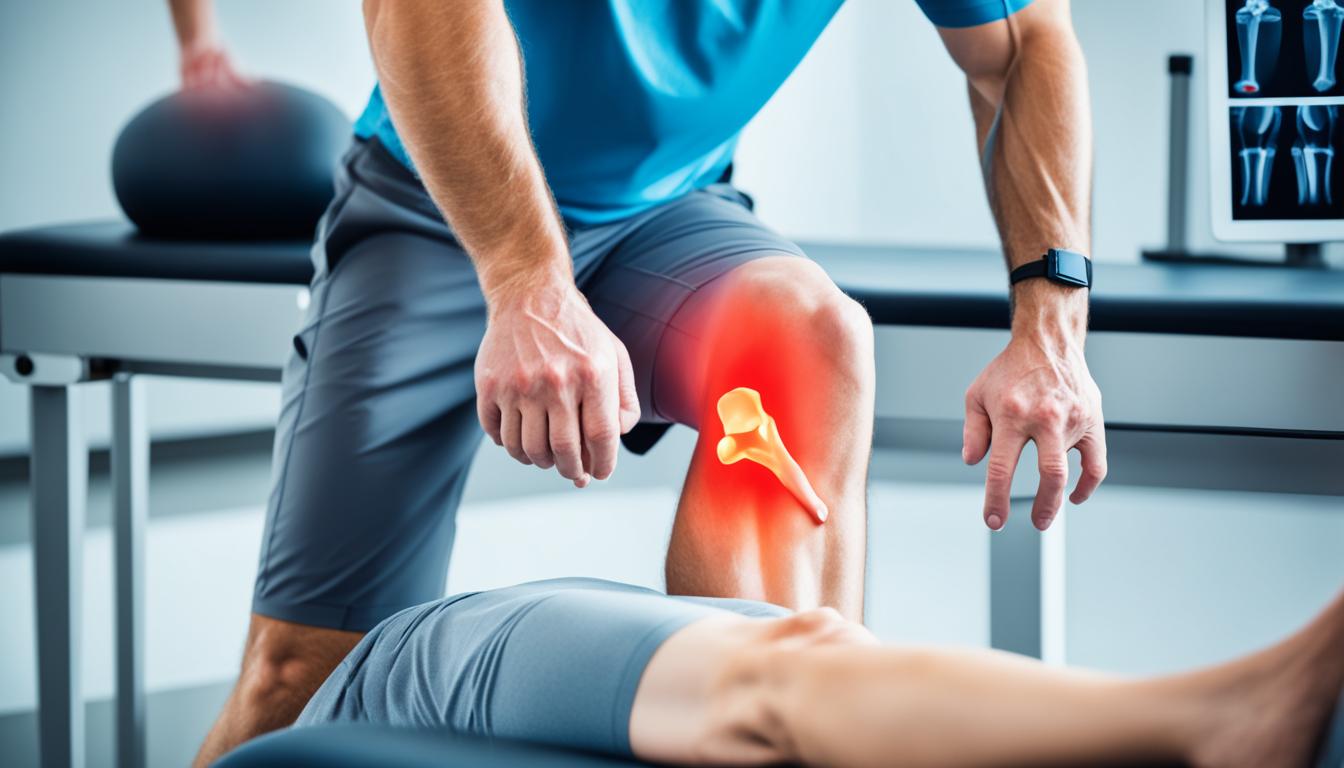Runner’s knee, or patellofemoral pain syndrome, is a well-known issue. It brings pain to the front of the knee and under the kneecap. This hurts athletes and non-athletes alike, maybe from lots of movement or how the knee’s built. This piece will dive into what it’s like, why it happens, how doctors find it, and cool treatments like using stem cells in Thailand.
Key Takeaways:
- Patellofemoral pain syndrome, or runner’s knee, causes pain around the front of the knee and the kneecap.
- It can be triggered by physical activities or anatomical issues.
- Symptoms include knee pain, anterior knee pain, and patellar tracking disorder.
- Diagnosis involves a thorough medical history, physical examination, and sometimes imaging tests.
- Treatment options include non-surgical methods like physical therapy and surgical interventions like arthroscopy or realignment procedures.
Understanding Patellofemoral Pain Syndrome
Patellofemoral Pain Syndrome (PFPS) causes knee and kneecap pain. It’s like a train that’s off track slightly. This issue affects many, from those who move a lot to those who don’t.
Things like weak or unbalanced muscles, flat or high arched feet, and a kneecap that sits too high can make knee pain start. These issues can make a knee move wrong, causing pain and making it hard to do things.
To manage PFPS, it helps to know about the knee joint’s workings. The patella is a shield in front of the thigh bone, protecting the knee. But, in PFPS, it may not move correctly. This causes pain and swelling.
Let’s dive deeper into how the knee joint works. It’s like a hinge, bending and straightening the leg. The patella helps the leg muscles work efficiently, but in PFPS, it moves wrong.
During movement, the patella should move smoothly. But in PFPS, it doesn’t. This causes pain and problems doing daily activities.
PFPS has many causes. Besides anatomy issues, overuse, wrong training, muscle imbalance, and stress on the knee can lead to PFPS.
Anatomical Issues Associated with PFPS
| Anatomical Issue | Description |
|---|---|
| Muscle Weakness or Imbalance | Weak or imbalanced muscles around the knee can affect the patellar tracking, leading to increased stress on the knee joint. |
| Flat Feet or High Arches | Abnormal foot mechanics can affect the alignment of the lower limb, altering the forces transmitted through the knee joint. |
| Higher Sitting Kneecap | A kneecap that sits higher than normal can disrupt the patellar tracking, causing it to rub against the femoral groove. |
Knowing about PFPS and its effects helps doctors choose the best treatments. This might include physical therapy, muscle exercises, and activity changes to help lessen pain and improve movement.
Now we understand more about PFPS, such as its impacts, we can explore how to diagnose and treat it.
Diagnosing and Treating Patellofemoral Pain Syndrome
To diagnose Patellofemoral Pain Syndrome (PFPS), doctors will start with your medical history and a physical check-up. They’ll look at your knee’s movement, strength, and any pain spots. They might also need X-rays or MRIs to be sure they’re right.
First off, they often try treatments without surgery. These include resting your knee and using ice, compression, and keeping it elevated (RICE). Physical therapy is important too. It helps you build up the muscles around your knee and make it more flexible. Doing exercises that are right for you can get you back in shape.
If you need extra help, your doctor might recommend a knee brace or shoe inserts. These can ease the pressure on your knee and add support. They might also use special tape to help your kneecap stay in the right place and feel better. But if these don’t work well, surgery such as arthroscopy may be needed. This is done to fix any issues in your knee joint, like fixing how your kneecap moves.
Another option gaining interest is stem cell therapy. This uses stem cells to help your knee joint heal. More studies are needed, but early results are hopeful. This treatment could one day make a big difference for people with Patellofemoral Pain Syndrome.

